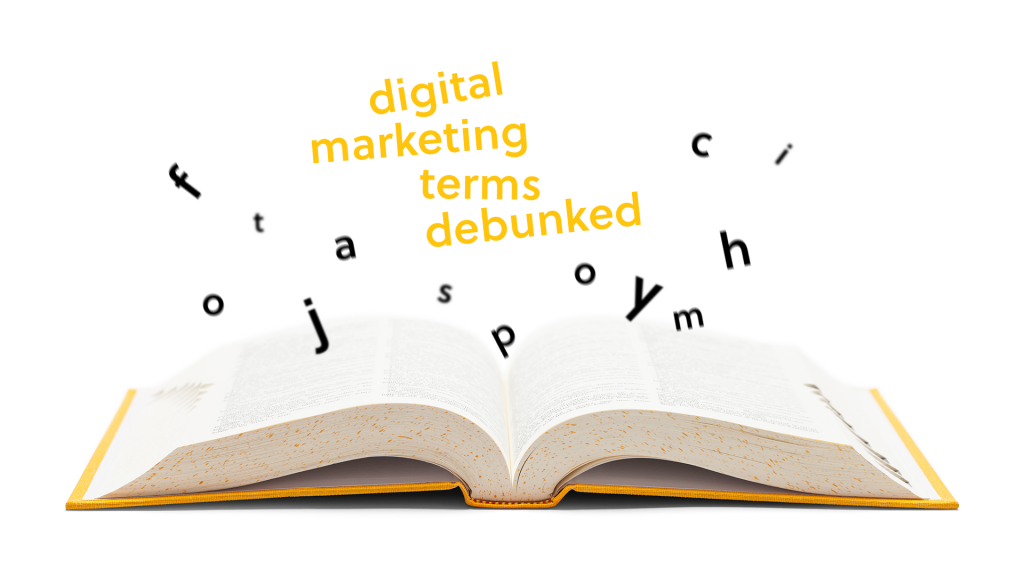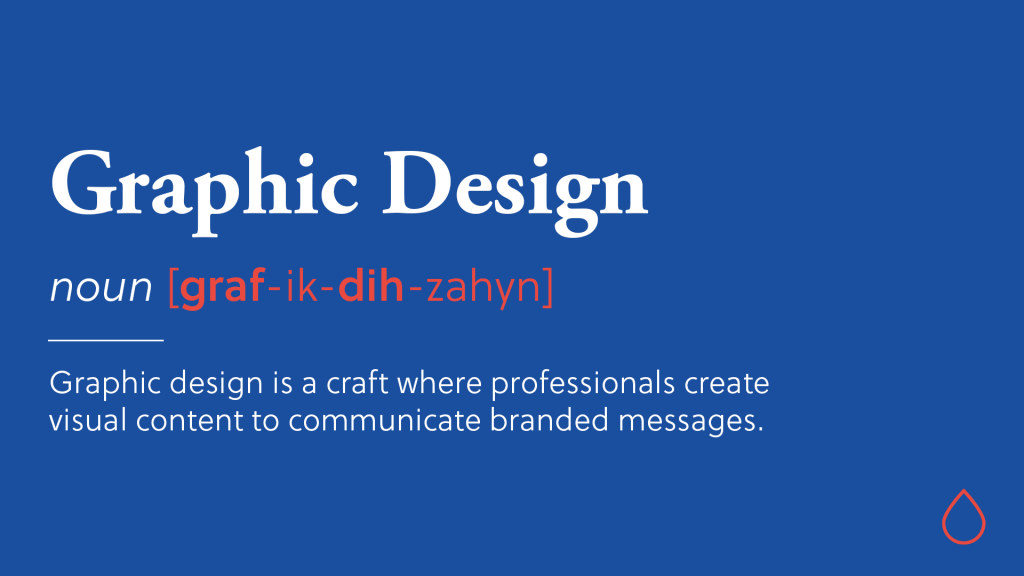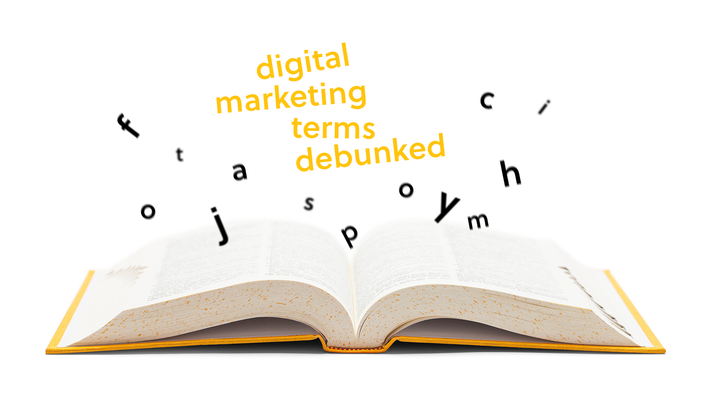Digital Marketing Terms Debunked
Recently had a meeting with a digital marketing agency? We bet you were bombarded with seemingly random three and four-letter terms, right? We feel you....It probably seemed like a crash course in learning a foreign language. But sometimes, there is no getting around the fact that we need to speak the right language in digital marketing circles (confusing as it may be). So, being the resourceful lot we are, here's a handy "read and keep" guide to help you get up to speed with the lingo. Okay (gasps for breath), here we go... 
Web Development
HTML: HTML stands for Hypertext Markup Language. It's a web development language that controls how a website is structured and built. Schema markup: Schema markup is a type of code that gets placed on a website to help Google return more relevant and informative search results for users. Sitemap: A sitemap (also known as a XML sitemap) basically acts as a blueprint of a website and helps Google find, crawl and index content. CSS: CCS stands for Cascading Style Sheets. It’s a design language that’s used to control the presentation of a HTML document. Tracking pixel: A tracking pixel is a snippet of HTML code that loads when a user visits a website or opens an email. It's very useful for tracking user behaviour, bounce rates and conversions. Wireframe: A wireframe is a simplified visual identity that represents the skeleton of a website prior to it being designed and developed. JavaScript: JavaScript is a scripting language that’s used to control dynamic website content such as interactive sign-up forms, animated images and auto-complete search suggestions. Alt Text: Alt text is an HTML attribute that provides alternative text when non-textual elements (mostly images) can't be displayed on a webpage. Bootstrap: In a nutshell, Bootstrap is a collection of reusable code written in JavaScript, HTML and CSS. It's also a frontend development framework that enables web developers to build fully responsive websites relatively quickly. API: API is an acronym for Application Programming Interface, which sounds complicated - it isn't. It's a type of intermediary software that allows two applications to communicate with each other. In practice, when a user sends a message on Facebook, they're using an API. HTTP: HTTP stands for Hypertext Transfer Protocol and is the foundation of the internet. It's an application layer that's used to load web pages using hypertext links. Python: Python is a general-purpose web development language. Unlike HTML, CSS and JavaScript, it can be used for a range of programming and software development projects besides general web development. RSS: RSS stands for Really Simple Syndication. It's an XML based format that's been the preferred standard for syndicating content across the internet. Ruby: Ruby is an open-source, object-oriented programming language and is different to others because it encourages web developers to write code for humans first and computers second. Spaghetti Code: Spaghetti code refers to a piece of code that is considered tangled and unstructured. It's caused by writing code that's not easy to change or not needed at all. SQL: SQL is short for Structured Query Language. It's a query language that's designed to facilitate retrieving specific information from databases or spreadsheets. 
Social Media Marketing
Lookalike Audience: Lookalike Audiences on Facebook can help businesses find their best new customers. It’s a powerful tool for better paid advertising because it takes a seed audience, then goes out and finds another group of users who are similar to that seed audience. FOMO: FOMO is an acronym that stands for the "fear of missing out". On social media, it's the feeling that users get when seeing posts about events they want to be part of. Hashtag: Hashtags are words or long-tail phrases that categorise content and track topics on Instagram, Twitter, Pinterest, TikTok to name a few. Hashtags are preceded by the # symbol, like #DigitalMarketingAgency or #CatsOfTheInternet. Fun fact, the technical term for a hashtag is "Octothorp". AMA: AMA is an acronym for "ask me anything", which originated in a subreddit where users started using it to prompt questions from others. Since then, the term has become extremely popular on other social media networks. Ephemeral Data: Ephemeral data is data that's not stored and disappears after a piece of content expires, like with Instagram Stories or Snapchat. Social Proof: Social proof refers to a psychological phenomenon in which social media users seek direction from their followers to determine how they're supposed to act in a certain or impending situation. Sentiment Analysis: Sentiment analysis basically highlights whether social media comments are positive, negative or neutral. Average Response Time: Average response time is a customer service metric that's used by social media marketers. It's the average time it takes to reply to questions or complaints. Trendjacking: Trendjacking is the tactic of sharing current events. Social media marketers often engage in trendjacking to seem relevant whilst gaining exposure. UGC: UGC stands for user-generated content. It can come in the form of posts, images, videos, reviews, articles and much more. Vanity Metrics: Vanity metrics are social media statistics that look positive but don't actually provide any valuable or actionable information.  [RESOURCES title="Other Resources" posts="5126" ]
[RESOURCES title="Other Resources" posts="5126" ]
Content Marketing
Whitepaper: The use of whitepapers can vary from industry to industry, but they're typically defined as authoritative, in-depth reports that present problems and provide solutions. Snackable Content: Snackable content refers to any video, text or infographic that is small and easy to consume. It helps to spread messages quickly and can increase brand interaction. Content Audit: A content audit is a process that involves evaluating existing website content and analysing its performance to identify opportunities where content can be improved, updated, deleted or re-promoted. Evergreen Content: Evergreen content refers to content that stays relevant for a long time like whitepapers, e-books and "how-to" videos. Keyword Density: Keyword density refers to the number of keywords included in content compared to the number of total words. Keywords should be included in content, but too many can result in search engine penalties. Guest Posting: Guest posting is a content marketing/SEO technique where you write a piece of content that isn't for your own website, normally in exchange for a link. CTA: CTA stands for "call-to-action. It refers to a button, phrase or form of encouragement that tells users to take a specific action and how. Infographic: An infographic is a visual representation of information and data. It's a form of content that's aimed to capture attention and enhance comprehension. Press Release: The main purpose of a press release is to report on a specific piece of information and as clearly as possible. Most press releases are created and distributed to notify the media in the hope of receiving press coverage in major publications. Above The Fold: The term “above the fold” originated during the early days of publishing and referred (and still does) to the content on the top half of a newspaper. Fast forward to the digital age, “above the fold” is used more to refer to the upper half of a webpage. AIDA: AIDA stands for Attention, Interest, Desire, Action. It's a well-known formula used by content writers to create effective copy that gets results.  [RESOURCES title="Other Resources" posts="6973" ]
[RESOURCES title="Other Resources" posts="6973" ]
PPC
Cost Per Action (CPA): Cost per action (also referred to as cost per acquisition) is a metric that measures how much a company pays in order to generate a conversion. Cost Per Click (CPC): Cost per click (CPC) refers to the amount of money a business or marketer pays for each click on a PPC ad. Cost per click is determined by a few factors, including maximum bid, quality score, and the ad rank of other competitors bidding for the same keyword. Cost Per Lead (CPL): Cost per lead (CPL) is a metric that measures how effective a PPC campaign is in terms of generating sales leads. It helps businesses and marketers to determine how much is an appropriate spend on their PPC campaigns. Cost Per Thousand Impressions (CPM): Cost per thousand impressions (CPM) is the total amount an advertiser pays for 1,000 impressions. A CPM of £4, for example, means it costs £4 for every 1,000 views of a PPC ad. Ad Rank: Ad rank is a value used to determine an ad’s position in the SERPS and is calculated by the ad’s quality score multiplied by the amount an advertiser bids for any given keyword. Bid: Also referred to as “keyword bid”, this is the maximum amount that an advertiser wants to spend for clicks for the keywords they have selected for their campaign(s). Conversion: A conversion is any action that an advertiser wants a user to take. This can include making an inquiry via a phone call, signing up for an email newsletter, filling in a contact form or buying a product and/or service. Conversion Rate: Conversion rate is the ratio of conversions divided by the number of ad clicks. This helps advertisers analyse how successful their campaigns are by determining how many of their clicks become conversions. Display URL: This is the URL that is shown with a PPC ad. This could be a destination URL or an alternative shorter one. It’s important to only have one display URL for an ad group that has the same root domain as the destination URL. Headline: A headline is the first line of text on a PPC ad. It can only contain a maximum of 25 characters and is the first thing a user will notice when they see an ad. Invalid Clicks: Also referred to as “click fraud”, invalid clicks are ad clicks that have been rendered by deliberately using automatic or in some cases malicious software. User Intent: User intent in a nutshell is what intention or goal an internet user has when they search for something on a search engine. Keyword Research: Keyword research is the process of identifying and optimising relevant keywords related to a main primary keyword. Identifying user intent also forms part of keyword research. Google Keyword Planner: Keyword Planner is Google’s own keyword research tool that helps advertisers identify keywords and negative keywords, keyword volume, and discover ranking opportunities.  [RESOURCES title="Other Resources" posts="6935" ]
[RESOURCES title="Other Resources" posts="6935" ]
Graphic Design
RBG: RBG is a colour model where red, green and blue light are combined in various ways to reproduce a broad variety of colours. RBG tends to be used more for on-screen purposes. Pantone: The Pantone Colour Matching System is a widely recognised colour reproduction system. Every colour hue is given its own number which makes it easy for graphic designers to reference and reproduce colours. Brand Style Guide: A brand style guide is a set of standards related to the design of a brand identity. The reason for having a guide like this is to ensure uniformity in style and formatting so that a brand is always represented the way it should be. Aspect Ratio: Aspect ratio refers to the proportional relationship between the width and height of a rectangle. The reason a rectangle is used is because the majority of screens are now wider than they are tall. White Space: White space (also referred to as negative space by graphic designers) is the area within a design that’s intentionally left blank. Icon: Icons are used to represent actions and/or objects. For example, a paintbrush could represent an artist creating a painting (action) or simply a paintbrush (object). Skeuomorphism: Bit of mouthful, right? But Skeuomorphism is basically when a digital element is designed to look like a replica of physical work. For example, think of Amazon's Kindle Store, where the bookshelf looks like one you'd see in a physical shop. Saturation: Saturation refers to the intensity of a colour. In other words, the more saturated a colour is, the more vivid it will be. Bleed: Bleed is a printing term that refers to the edge of a sheet that’s going to be trimmed off. It’s a way of ensuring that none of a design accidentally gets cut off during the printing process. Golden Ratio: The golden ratio is when you take 2 objects, divide the larger by smaller and get the result of 1.6180 (or around that number). Knolling: Knolling is the act of purposely arranging physical objects so that they're at 90-degree angles from each other, then taking photos of them from above. Resolution: Resolution refers to the quality of an image. As a general rule of thumb, the higher resolution, the higher the quality. Opacity: Opacity enables graphic designers to make certain elements of a design transparent. The lower the opacity, the more transparent an element is. If the opacity is at 100%, this means the element is solid. Kerning: Kerning refers to the adjustment of spaces between a pair of letters within the same word to make it more readable and appealing. PSD: PSD is short for Photoshop Document and is an uncompressed working raster image file that is created by graphic designers using Adobe Photoshop.  [RESOURCES title="Other Resources" posts="7334,7194" ]
[RESOURCES title="Other Resources" posts="7334,7194" ]
SEO
Link Building: This is the process of gaining links on other websites and lead back to yours. The higher authority of these other websites, the more valuable the links are. Meta Title: A meta title is essentially the name of a web page. Meta titles help Google understand what content is included on web pages and in what context. Meta Description: A meta description is the short amount of copy that's displayed underneath a website's link on Google. They're typically 145 - 159 characters in length. Long-tail Keyword: A long-tail keyword is a keyword that contains three or more words. Long-tail keywords are used to target niche audiences. Black Hat SEO: Black hat SEO refers to a set of practices that are used to improve a website's ranking position through means that violate the Google's terms of service. White Hat SEO: On the flipside of black hat SEO, white hat SEO refers to tactics that are in line with Google's terms of service. Cloaking: Cloaking is an unethical SEO tactic where a web page seen by visitors is different from the one ranking on the search engines. If those using this technique are discovered, their website(s) will be penalised. Keyword Stuffing: Keyword stuffing refers to the excessive, unnatural use of keywords on a webpage for SEO purposes. It's outdated and now considered a "black hat SEO tactic". Webmaster: A webmaster is a person who's responsible for managing a website. They're referred to as the owner of a website and the first point of contact. Hidden Text: Text that's on a web page in the same colour as the background is considered as "hidden text". The practice of using hidden text is a "black hat SEO tactic" because it's an attempt to fool the search engines. Bounce Rate: Bounce rate is the percentage of visitors who leave a website quickly without really digesting any of the content.  [RESOURCES title="Other Resources" posts="6907,7771" ]
[RESOURCES title="Other Resources" posts="6907,7771" ]
Email Marketing
Open Rate: Open rate is the number of emails opened by recipients in a campaign divided by the total number of emails sent. GDPR: GDPR refers to the General Data Protection Regulations. It's a law that was bought in during 2018 to better protect people's data and personal information. Unsubscribe: This is pretty much what it says on the tin. It's when a subscriber chooses to discontinue receiving emails. All businesses are legally required to offer a quick and easy way of opting out in every email they send. A/B Test: An A/B test is a process of sending 1 campaign variant to a subset of subscribers and a different variation to another subset of subscribers. It's a method that gives businesses an insight into what type of emails work best in relation to their goals. Drip Campaign: A drip campaign refers to automatically sending a limited number of emails to an audience based on actions they take or changes in their status. Drip campaigns are highly effective at turning visitors into buyers and encouraging repeat purchases from an otherwise dormant audience. False Positive: This is when a legitimate permission-based email is flagged as spam when it hits a recipients inbox. CTR: CTR (Click-Through-Rate) refers to the number of unique clicks made by recipients divided by the total number of emails sent in a single campaign. Postmaster: Postmaster basically refers to the individual or organisation that's sending emails to their customers and/or prospects. Spam: Also referred to as junk, these are messages that are unsolicited and filtered out of an inbox. Emails can be classified as spam if they're sent to recipients who didn't opt in to receive them. HTML Email: This is an email that has been coded using HTML. The language makes it possible to get creative with email design and supports graphics and videos. Abandoned Cart Email: Abandoned cart emails are sent to customers who have visited a website, added products to their cart and then left without buying them. They're incredibly effective as a sales recovery marketing tactic. CAN-SPAM: CAN-SPAM stands for “Controlling the Assault of Non-Solicited Pornography and Marketing Act of 2003”. It's an American Law that regulates the transmission of all commercial email messages sent by individuals, businesses and non-for-profit organisations.  [RESOURCES title="Other Resources" posts="7610,7572,6834" ]
[RESOURCES title="Other Resources" posts="7610,7572,6834" ]
Digital Marketing Terms Round-Up
So as you can see, it's a bit of a minefield when it comes to learning the terms surrounding digital marketing. We think we've covered most bases, though no doubt more terms have come about since we've hit the publish button. So, what we're going to do, is regularly update this blog so you can come back to it whenever you have a "wait, what on earth did they say" moment. The question is, can you now tell your "eviver" from your "latigid"? Okay, we just made that up. Kinda...













